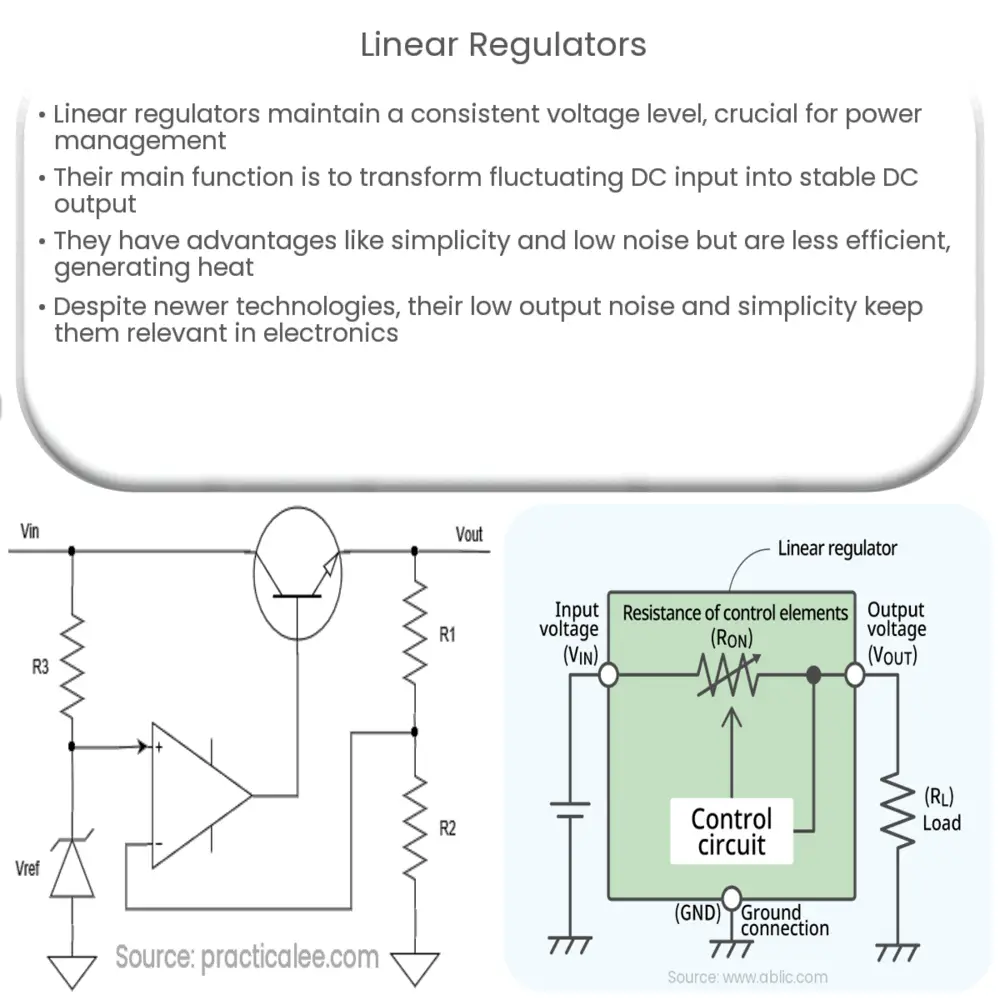Explore the basics of linear regulators, their types, advantages, and applications, and compare them with switching regulators.

Understanding Linear Regulators
Linear regulators, a crucial element in the domain of power management, are designed to maintain a steady voltage level. They are especially relevant in scenarios where a consistent output voltage is required, regardless of input voltage variations or output load changes.
Function and Application
The primary function of a linear regulator is to convert a fluctuating DC (Direct Current) input into a stable DC output. This is accomplished by dropping excess voltage in a series active element controlled by a high gain differential amplifier. It is akin to a voltage divider that dynamically adjusts itself based on the input voltage and load.
Types of Linear Regulators
- Series Regulators: In series regulators, the regulating device (a transistor typically) is in series with the load. The current supplied to the load passes through this device, and by adjusting the resistance of this device, the output voltage can be regulated.
- Shunt Regulators: Conversely, in shunt regulators, the regulating device is in parallel with the load. The excess current is diverted away from the load to maintain a constant output voltage. These are less commonly used due to their less efficient nature and the power they waste as heat.
Advantages and Disadvantages
Linear regulators offer several advantages, including their simplicity, low noise, and fast response time. They provide clean, noise-free output voltage, which is especially beneficial in sensitive electronic devices. However, they also have some notable drawbacks. The significant one is their inefficiency, particularly when the difference between input and output voltage is large. This inefficiency is due to the power dissipation in the form of heat.
Applications of Linear Regulators
Linear regulators find applications in a wide array of electronic devices. They’re commonly used in battery-powered devices due to their ability to provide a stable output voltage. They’re also found in radio frequency and audio applications because of their low output noise.
Despite the advent of more efficient regulators like switching regulators, linear regulators continue to be popular in scenarios where simplicity and low output noise are prioritized over efficiency. Understanding their working principle, advantages, and disadvantages is key to utilizing them effectively in electronics design.
Working Principle of Linear Regulators
A linear regulator operates by using a voltage-controlled current source to drive a transistor that can pass more or less current as needed through the load. A feedback mechanism, often a differential amplifier, continuously adjusts the voltage across the base-emitter junction of the transistor to keep the output voltage constant. The feedback mechanism ensures that the output voltage is always maintained at the desired level, irrespective of variations in the input voltage or the load.
Linear Regulators vs. Switching Regulators
While both linear regulators and switching regulators are used for voltage regulation, they have different strengths and weaknesses. Linear regulators are simpler and produce less noise, making them suitable for low-voltage, low-power applications or when the input and output voltages are close. However, they are less efficient and generate more heat.
On the other hand, switching regulators are more efficient, particularly at higher voltages, but are more complex and can generate noise that may interfere with sensitive electronic components. The choice between linear and switching regulators depends on the specific requirements of the application, such as the acceptable noise level, efficiency, and cost.
Future of Linear Regulators
While the trend towards miniaturization and higher efficiency in electronics might suggest a decline in the use of linear regulators, they continue to be an essential tool in the designer’s toolkit. This is because, despite their relative inefficiency, they are unbeatable in terms of simplicity and low noise performance. Advances in semiconductor technology are also making linear regulators more efficient, extending their lifespan in the industry.
Conclusion
In conclusion, linear regulators are a fundamental component in power management systems, offering a reliable solution for maintaining a stable voltage output. Despite their inefficiency and heat generation, they remain relevant due to their simplicity, low noise, and fast response time. As technology advances, improvements in linear regulator designs continue to be made, enhancing their efficiency and making them suitable for a broader range of applications. Understanding the principles and applications of linear regulators is therefore vital for anyone involved in the design and development of electronic systems.

